Chapter 2 Primitive Man In The Indian Sub Continent Evolution Of Man
Thousands and thousands of years ago, the earth abounded in huge animals and flying birds. Under the sky, the earth was covered with jungles. Tall trees and tall grass covered the face of the earth.
Among the animals, there were the apes which were tailless primates. It is from these apes that, through thousands of years of evolution, modern humans (called Homo sapiens) came into existence.
The first near-humans that evolved from the ape were called hominids. The fossilized remains of the first hominids were discovered in Ethiopia.
Read and Learn More WBBSE Notes For Class 6 History
They lived about 5 million years ago. This species was named Ardipithecus ramidus. The next in the stage of evolution was the Australopithecus. They were called the hominids of the south. This was about 4 million years ago.
In 1974 two archaeologists, Don Johnson, and Maurice Tieb discovered the fossil skeleton of this hominid. They named it ‘Lucy’. Lucy is at least as old as 3 million years.
“WBBSE class 6 history chapter 2 notes”
Next in the stage of evolution came a hominid named_Homo hails. This hominid evolved about 2.5 million years ago. Their fossils were first discovered in Tanzania in 1961.
They used their hands in many ways. Probably they were the first to use stones as weapons. Next comes Homo erectus (the Upright Man) of 2 million years ago. The Homo erectus stood erect.
The fossils of Homo erectus were found in many places in Africa and Southeast Asia. But the earliest remains were found in Peking (now Beijing). That is why the Homo erectus is called Peking Man.

They learned to light a fire. Probably they struck flint stones. And this resulted in a fire. This was how the fire was first lit. They learned to make the hand axe. Because they used fire, they could live in colder places.
In the Hunsgi valley in Karnataka, hand axes and similar other weapons have been found. These were used by the Homo erectus. Next in the stage of evolution was the Neanderthal Man.
“primitive man in the Indian subcontinent WBBSE notes”
He is so called because his remains were first discovered in Germany’s Neander valley. The Neanderthal man is very much near the modern man in physical features, though a little shorter. They came about 500,000 years ago.
Historians say that the Neanderthal men lived in Africa as late as about 250,000 years ago. The Neanderthal men are also known as Homo sapiens. The real modern men appeared on earth about 100,000 years ago.
Their first traces were found in Africa. They are called Homo sapiens sapiens. They were hunters. They hunted in groups. They wore animal hide to protect themselves from the cold.
Gradually they learned to sharpen stones also. They warmed themselves up with fire and used fire to ward off wild animals.
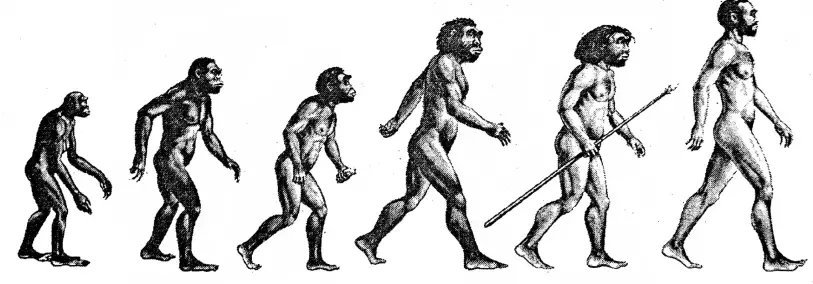
Chapter 2 Primitive Man In The Indian Sub Continent A Table Of Man’s Evolution
Ardipithecus ramidus
- Evolved about 5 million years ago.
- Fossils found in Ethiopia.
- Used stones to drive away wild beasts.
- Lived in caves.
Australopithecus
- Evolved about 4 million years ago.
- Stout-bodied hominids walked with a stoop.
- Used stones to drive away wild beasts.
Homo habilis
- Evolved about 2.5 million years ago.
- Fossils were first found in Tanzania in Africa.
- Used their hands in many ways.
- Used stones as weapons.
- Ate raw meat.
| Class 6 History | Class 6 Social Science |
| Class 6 Geography | Class 6 Science |
| Class 6 Maths | Class 6 Science MCQs |
| Class 6 General Science | Class 6 Maths Solutions |
| Class 6 Geography | Class 6 Hindi |
Homo erectus
- Evolved about 2 million years ago.
- Stood erect. Called Upright Men.
- Learned to light a fire and use it. ’
- Were hunters.
“summary of class 6 history chapter 2 WBBSE”
Neanderthal man
- Evolved about 500,000 years ago.
- Fossils were first found in the Neander valley in Germany.
- Were slightly shorter than today’s humans. But were much stronger.
- Were formidable hunters.
- Were called Homo Sapiens neanderthalis.
Modem Humans (Homo Sapiens Sapiens)
- Evolved about 200,000 years ago.
- Oldest fossils found in Ethiopia in Africa.
- Hunted in groups.
- Ate burnt meat.
- Wore animal skin to protect themselves from the cold. I learned to make spears.
- About 30,000 years ago they began to spread out into Europe and Asia.
Chapter 2 Primitive Man In The Indian Sub Continent Two Great Changes
Two things brought a great change in the life and habits of primitive men. One was the use of fire. The lighting of the fire was perhaps an accident. Before men learned to light a fire, they had the experience of fire already.
They must have seen a forest fire. Maybe they brought burning wood into their caves to light it or to warm themselves up. But one day while striking two flint stones, they unknowingly lit the fire.
From then on lighting of fire was easy. Now they roasted or singed meat and ate it. Gradually men gave up eating raw meat. Singed or burnt meat and bone were softer than raw meat and bone.
“important questions from primitive man in the Indian subcontinent”
Gradually the canine teeth became smaller. Eating singed meat and fruits did not demand big or sharp teeth. The jaws, as a result, became small.
The second great change was man’s standing erect and walking straight. The legs were used for walking only, men could now use their hands in a variety of ways and for various purposes.
The two hands were now able to hold, to grip, to wield the hands to make things.
Chapter 2 Primitive Man In The Indian Sub Continent The Three Stone Ages
You now know that according to the use of stones, three stone ages have been named by historians. These are the Palaeolithic Age or the Old Stone Age, the Mesolithic Age or the Middle Stone Age, and the Neolithic Age or the New Stone Age.
To have a clear idea of the three stone ages, you will do well to look at the following table.
Old Stone Age
Roughly began about 2 million years ago. Men hunted animals and ate raw meat. Men ate fruits too. Men used big and crude stones to hunt. Old Stone Age lasted till about 10,000 B.C. Men lived in open spaces or sometimes in caves.
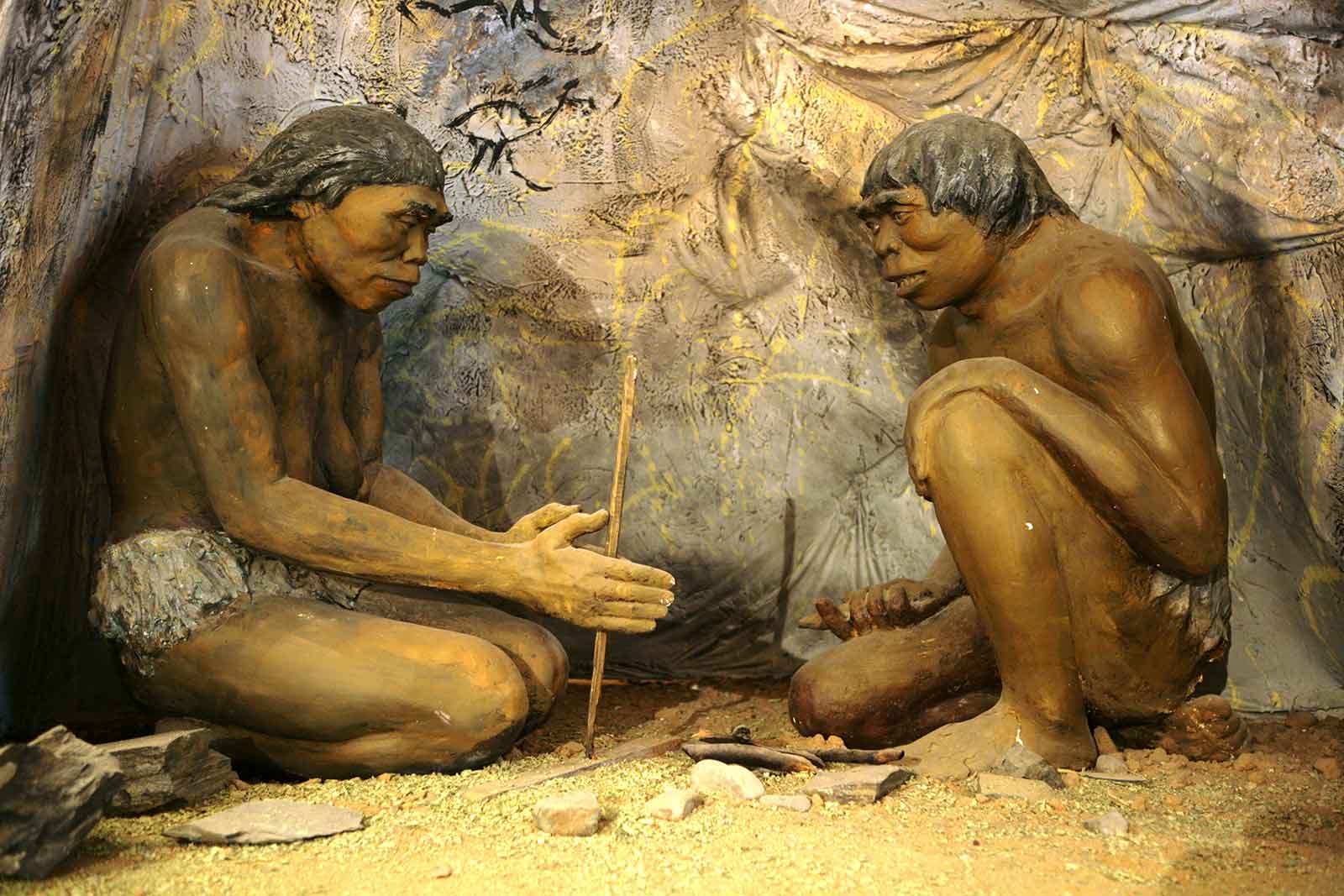
Middle Stone Age
The Mesolithic Age was the transition from the Palaeolithic to the Neolithic Age. Began about 12,000 B.C or 10,000 B.C and lasted till about 8000 B.C. Men learned to use sharper and less heavy stones as weapons. Men lived mainly in caves. Learned to build houses.
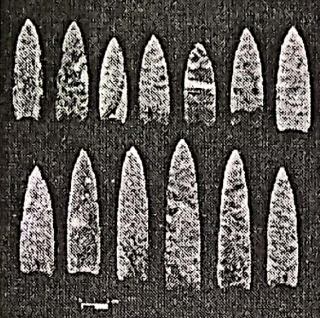
New Stone Age
Began about 8000 B.C. and lasted till about 4000 B.C. Men learned to sharpen stone; Learned to make weapons, implements, and pottery; Gave up nomadic habits, and built houses. Agriculture started.
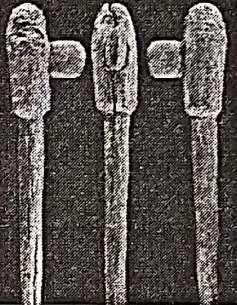
Chapter 2 Primitive Man In The Indian Sub Continent The Palaeolithic Age In The Indian Sub Continent
It is said that the Old Stone Age in the Indian Sub-continent began roughly in about 250,000 B.C. of 200,000 B.C The earliest traces of this age were found in the Kashmir valley and in the Soan basin in Pakistan.
Very old stone tools and implements have been found in the Swat valley of Kashmir, in Hathnora in Madhya Pradesh, in the Potwar plateau in Pakistan, in the Sivalik mountain in Himachal Pradesh, in Maharashtra’s Bori.
“WBBSE class 6 history chapter 2 key points”
The skull of a woman of Homo erectus was found in Hathnora. And tools were found in other places. Most of the tools discovered were of the hand-axe type. Some too were chopper-like tools.
The hominid species that lived in India about 2 million years ago was the Homo erectus. Stone tools of about 2 million years ago were found in Madhya Pradesh, Karnataka, and Rajasthan.
Life of the paleolithic men
How was the life of the Palaeolithic man? It is not difficult to understand that their life was not at all easy. The climate was too cold. The Ice Age was running then.
Ice sheets covered the mountains. In other places of the sub-continent, there was heavy rainfall. Old Stone Age people mostly lived in hilly areas near rivers or water sources so that they could live in caves and get enough water.
They could not prepare their food and depended on hunting. That they hunted in groups is clear from cave paintings. They also gathered fruits. That is why they are called hunters and gatherers.
They were nomads and moved from place to place for food and shelter. They drew or painted pictures in the caves where they lived. In the cave of Bhimbetka in Madhya Pradesh, archaeologists have discovered paintings of the Old Stone Age.
These paintings give us an idea of the animals they hunted and also their way of life. The use of fire enabled them to give up eating raw meat. They roasted or singed meat and ate it.
The tools used
The Old Stone Age men used stone tools of various kinds. The tools excavated were crude. They used hand axes and choppers, both being rather heavy. Stone blocks were used to hurl at wild beasts.
Deer, boars, and similar other animals could be killed with big stone blocks. But horses, bison, and mammoths could not be killed thus. So for this hand axes and spears were used.
Did they make clothes?
Old Stone Age men gradually learned to wear clothes made of animal skin and fur, as also tree leaves and bark. This we know from cave paintings.
The idea of covering their body first came when they saw that it gave them warmth. So clothes were protection against the cold.
Chapter 2 Primitive Man In The Indian Sub Continent The Middle Stone Age
The Mesolithic Age or the Middle Stone Age was a period between the Old Stone Age and the New Stone Age. This period was shorter than the Old Stone Age.
The Middle Stone Age, as you noticed in the table shown previously, started roughly in 12000 B.C. and lasted till about 8000 B.C.
Archaeologists and historians tell us that already in the Middle Stone Age men in India and elsewhere learned to speak meaningfully. This made group hunting easier.
It has also been known that men of that period made use not only of stone but also animal bone and animal horn and wood. Weapons and implements made of bone and wood have been found in the Fa Hien cave of Sri Lanka, at Patne in Maharashtra, Sarai Nahar Rai, and Mahadaha in Uttar Pradesh.
Bone ornaments have been found at Mahadaha. It is guessed that such ornaments were worn by men, not by women. In many places, evidence of the use of fire to roast meat have been found.
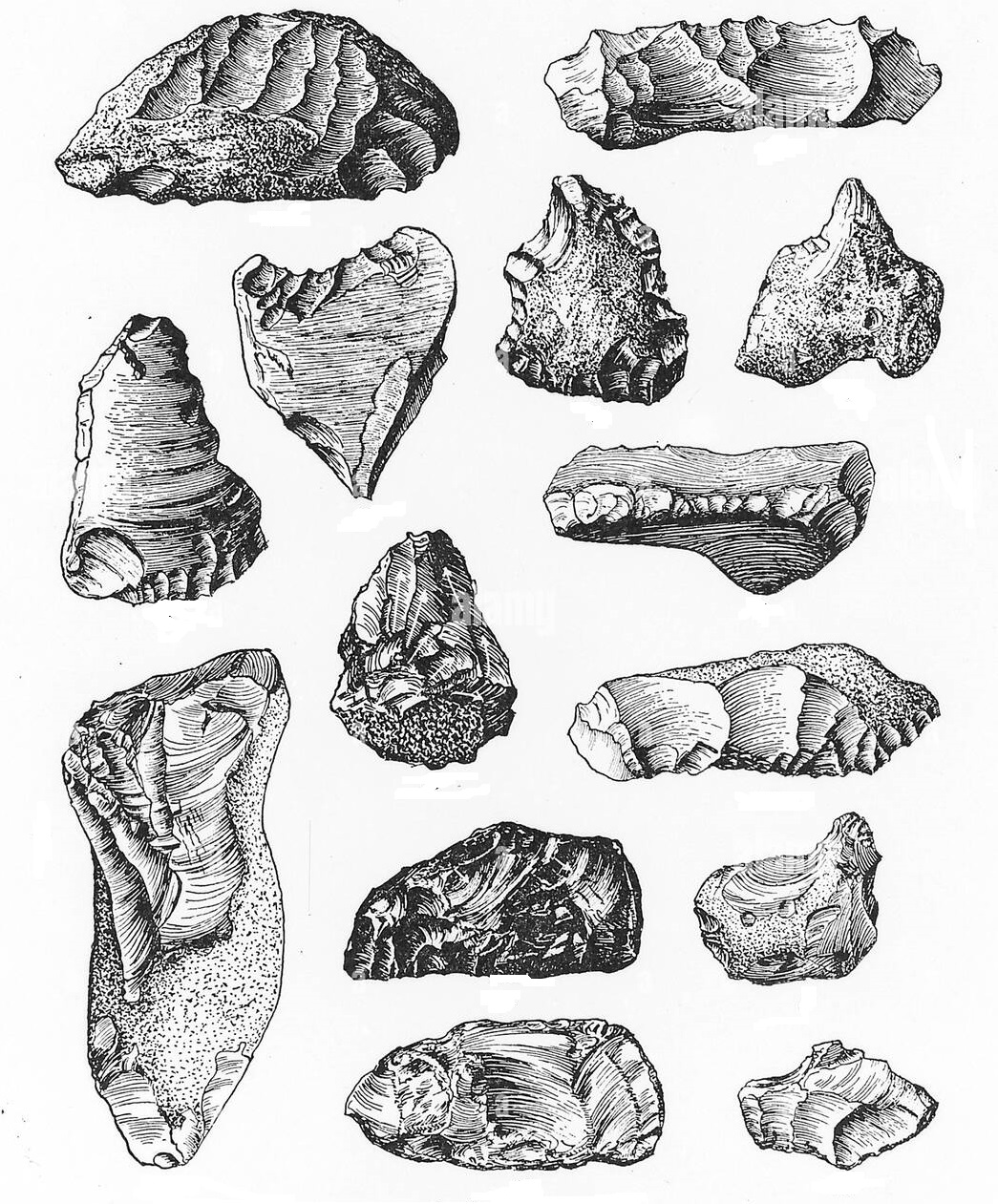
Arrow-heads and spear¬like weapons made of bone have been found at Mahadaha and have been found at Sarai Nahar Rai. crushed or ground corn seeds. But they could not produce them.
Men were generally short-lived. From examining the skulls found at Mahadaha, archaeologists have come to the conclusion that most of those buried were under 28 years.
A good number of burials have been discovered at different places. Bone ornaments and bones of hunted animals were buried along with the dead. This shows that men had some kind of primitive religious belief. Probably they believed in an afterlife.
“how early humans lived in the Indian subcontinent”
Mesolithic men learned livestock farming. As a result, there was then plenty of supply of food, milk, and meat. In Bangor or Baghor in Rajasthan, many relics or remains of the Mesolithic Age have been found.
Stone and bone implements have been found in great numbers. Microliths or very small stone tools were a feature of the Mesolithic Age. Such microliths have been found in Bangor, Mahadaha, and Sarai Nahar Rai.
Chapter 2 Primitive Man In The Indian Sub Continent The Neolithic Age
We told you that the Neolithic Age or the New Stone Age came in about 8000 B.C. But you must remember that it did not come at the same time in all regions.
The earliest Neolithic culture was discovered in Iran and Iraq. In other regions of Asia, Neolithic culture developed later.
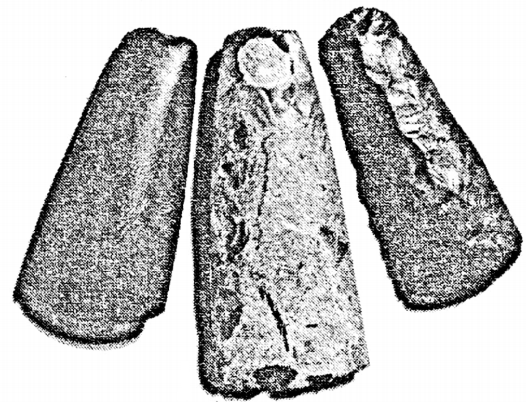
Now you may ask:
what were the features of this New Stone Age? In other words, what was new in this age? The features were as follows:
- The stones used in making tools, implements and weapons were sharper and more polished than in the previous ages. But less polished stones were not discarded altogether.
- This age marks the beginning of a sort of agriculture. They learned how to plant a crop. They watched it grow and then harvested it in due time.
- Men learned to make potteries in the Neolithic Age.
- Men now domesticated animals. Cattle, dogs, sheep, goats, and pigs were domesticated. Gradually men depended more on agriculture and animal farming than on hunting. The period of hunting and gathering was now over. The dog was used in guarding and in keeping watch. The cow and the goat gave milk. Other animals gave meat.
Chapter 2 Primitive Man In The Indian Sub Continent The Neolithic Age In The Indian Sub Continent
Traces of the New Stone Age culture have been found about 8000 B.C. in the Indian sub-continent. Polished and sharp tools brought important changes in man’s life. Implements were now used to grind, pound, and rub stones.
So far more sophisticated tools and implements could now be made. Small grinding stones have been found in Sarai Nahar Rai and Mahadaha in Uttar Pradesh. Their date has been fixed between 8000 B.C. and 6000 B.C.
We told you that agriculture first came in the Neolithic Age. But how? Archaeologists believe that men for a long time gathered fruit and in the process, they noticed that the seeds they threw down brought forth small shoots after a few days.
They now knew the mystery of growing plants. This was how men had the first lessons in agriculture. They first planted a crop, watched how it grew, and then harvested it when the time came.
Agriculture now compelled men to give up their nomadic habits. They had now settled in one place for the sake of agriculture. Uncertainties of hunting life could now be eliminated largely.
As agriculture became widespread, domestication of cattle was much easier. For enough food for the domesticated animals was now available. The stubble, that is, the small stalk left after harvesting could now be used as fodder for the cattle.
“tools and weapons used by primitive man class 6”
Archaeologists and historians tell us that men in the previous ages grew the habit of sharing what was obtained by hunting and gathering. But an important change took place in the Neolithic Age.
Men now gave up the ‘habit of sharing. A family or group which produced crops owned it. In this way, society became a little complex. Gradually class system and the private property appeared.
A famous British archaeologist described the Neolithic Age as the Neolithic Revolution. The reason is that in the Neolithic period, great changes came in man’s life.
Traces of such advance were found in our sub-continent too. On the west of the Indus basin, traces of Neolithic changes have been found in Mehrgarh in Baluchistan (now in Pakistan).
They are dated roughly between 7000 B.C. and 4000 B.C. Historians, now do not use the word, ‘revolution’ but the fact is that great changes occurred over thousands of years.
Chapter 2 Primitive Man In The Indian Sub Continent Sites Of Neolithic Culture In The Sub Continent
The most important sites where Neolithic culture have been discovered in our sub-continent are Mehrgarh, Kili-Gul-Mahamad, and Mundigak. Mehrgarh is near the Bolan pass. Kili-Gul-Mahamad and Mundigak are situated in the south of Afghanistan.
In the Kashmir valley to there were sites of Neolithic culture. Burzahom, near modern Srinagar, was an important site. Sites were discovered in Rajasthan also. There were sites in the Swat valley in the Himalayas.
Crops like wheat and barley have been found in most of these sites. Fossilized remains of dogs and cattle have been discovered in the burials.
Life of the people
In the Indian sub-continent, the Neolithic men mostly lived in houses of mud, brick, and stone. They learned to use the potter’s wheel and made pots and vessels and painted them.
Painted pottery has been discovered at Mehrgarh, east Rajasthan, the Swat valley, Kalibangan, and Banawali. The people are known to mostly settle near rivers. Some still lived upland and some cleared forests to live in.
“stone age and early human life WBBSE class 6”
You already know that the people had learned to produce crops. Making pots and vessels helped them to store grain. As the Neolithic Age advanced, people learned to make cloth and used it in place of animal skin.
The burials tell us a number of things about the Neolithic people. They buried not only the dead but put tools, dead animals, and ornaments. This shows the use of a kind of ritual.
WBBSE Notes For Class 6 History
-
- WBBSE Notes For Class 6 History Chapter 1 The Idea Of History
- WBBSE Notes For Class 6 History Chapter 2 Primitive Man In The Indian Sub Continent
- WBBSE Notes For Class 6 History Chapter 3 Ancient History Of The Indian Sub Continent
- WBBSE Notes For Class 6 History Chapter 4 Ancient History Of The Indian Sub Continent
- WBBSE Notes For Class 6 History Chapter 5 Indian Sub Continent In The 6th Century BC
- WBBSE Notes For Class 6 History Chapter 6 Expansion Of Empire
- WBBSE Notes For Class 6 History Chapter 7 Economic Condition And Livelihood
- WBBSE Notes For Class 6 History Chapter 8 Culture In ancient India
- WBBSE Notes For Class 6 History Chapter 9 India And The Contemporary World
